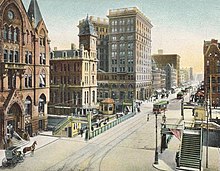History of Syracuse, New York
This article needs additional citations for verification. (August 2019) |
| Census | Pop. | Note | %± |
|---|---|---|---|
| 1850 | 22,271 | — | |
| 1860 | 28,119 | 26.3% | |
| 1870 | 43,051 | 53.1% | |
| 1880 | 51,792 | 20.3% | |
| 1890 | 88,143 | 70.2% | |
| 1900 | 108,374 | 23.0% | |
| 1910 | 137,249 | 26.6% | |
| 1920 | 171,717 | 25.1% | |
| 1930 | 209,326 | 21.9% | |
| 1940 | 205,967 | −1.6% | |
| 1950 | 220,583 | 7.1% | |
| 1960 | 216,038 | −2.1% | |
| 1970 | 197,208 | −8.7% | |
| 1980 | 170,105 | −13.7% | |
| 1990 | 163,860 | −3.7% | |
| 2000 | 147,306 | −10.1% | |
| 2010 | 145,170 | −1.5% | |
| 2020 | 148,620 | 2.4% | |
| [1][2] | |||
Early history


French missionaries were the first Europeans to come to this area, arriving to work with and convert the Native Americans in the mid-17th century. At the invitation of the
The mission was short-lived, as the
Just after the
Jesuit missionaries visiting the Syracuse region in the mid 1600s reported
19th century

Syracuse went through several name changes before 1824, being first called Salt Point (1780), then Webster's Landing (1786), Bogardus Corners (1796), Milan (1809), South Salina (1812), Cossits’ Corners (1814), and Corinth (1817). The
In 1825, the Village of Syracuse was officially incorporated. Five years later the Erie Canal, which ran through the village, was completed. The Village of Syracuse and the Village of Salina were combined into the City of Syracuse on December 14, 1847. Harvey Baldwin was the first mayor of the new city.[5]
Early industries
Lewis Hamilton Redfield started the first weekly newspaper, Onondaga Register which published its first issue on September 17, 1814.[6]
The opening of the Erie Canal caused a steep increase in the sale of salt, not only because of the lower cost of transportation, but because the canal led New York farms to change their production from wheat to pork and curing pork required salt. Until 1900, the bulk of the salt used in the United States came from Syracuse.[7] As salt production climbed, the processing became increasingly mechanized and local industry became more generalized. The population grew from 250 in 1820, to 22,271 in 1850.
The first
Since the discovery of large deposits of
The closing of the Onondaga Salt Springs Reservation in the early 1900s and the end to mining brine in the southern part of the Tully valley in the late 1900s marked the end of salt mining in the Syracuse region. However, groundwater flowing along the southeastern shore of Onondaga lake in Syracuse still allows salty water from a thousand feet below the southern Tully valley to flow by gravity, feeding salt springs around the lake where the Salina shale contains no halite beds.[4]

Abolitionism and the Underground Railroad
Syracuse became an active center of the
Industry and education in the late 19th century
The salt industry declined after the
Syracuse University was chartered in 1870 as a Methodist-Episcopal institution.
The
20th century


By the 20th century, Syracuse University was no longer sectarian and had grown from a few classrooms located in downtown Syracuse into a major research institution. It is nationally recognized for its college basketball, college football, and college lacrosse teams. In 1911, under the leadership of Syracuse University trustee, Louis Marshall, the New York State College of Forestry was re-established in close association with Syracuse University. It since has evolved into the SUNY-ESF. Le Moyne College was founded in 1946 and Onondaga Community College in 1962.
Syracuse's population peaked at 221,000 in 1950, when the Census Bureau reported Syracuse's population as 97.7%
Much of the city fabric changed after World War II, although
The manufacturing industry in Syracuse began to falter in the 1970s. Many small businesses failed during this time, which contributed to an already increasing unemployment rate. Rockwell International moved their factory out of the state, and General Electric moved its television manufacturing operations firstly to Suffolk, Virginia, and later to Singapore. The Carrier Corporation moved its headquarters out of Syracuse and outsourced manufacturing to Asian locations. Nevertheless, although city population has declined since 1950, the population of Syracuse metropolitan area has remained fairly stable, even growing by 2.5 percent since 1970. While this growth rate is greater than in much of upstate New York, it is far below the national average during that period.
See also
- Central New York Military Tract
- History of the Seal of the City of Syracuse
- National Register of Historic Places listings in Syracuse, New York
References
- ^ Gibson, Campbell (June 1998). "Population of the 100 Largest Cities and Other Urban Places in the United States: 1790 to 1990". United States Census Bureau, Population Division. Detailed Tables 8—21. Archived from the original on July 8, 2010. Retrieved August 15, 2010.
- ^ "Syracuse city, New York – Population Finder". United States Census Bureau. Archived from the original on February 12, 2020. Retrieved August 15, 2010.
- ^ "Science Tribune". www.tribunes.com.
- ^ a b "New York Water Science Center" (PDF). ny.water.usgs.gov.
- ^ "Our Founders" (PDF). City of Syracuse. 2004.
- ^ Searing, Robert (4 May 2021). "Inspired by Benjamin Franklin, Lewis Redfield started the first newspaper in Onondaga County". The Post-Standard. Retrieved 15 May 2021.
- ^ Encyclopedia AMERICANA,vol.26,1968
- ^ a b "The Jerry Rescue - New York History Net". www.nyhistory.com.
- ^ History of the Franklin Company. Baldwinsville, New York.: Baldwinsville Messenger. January 2003.
- ^ "Race and Hispanic Origin for Selected Cities and Other Places: Earliest Census to 1990". U.S. Census Bureau. Archived from the original on 2012-08-12.
